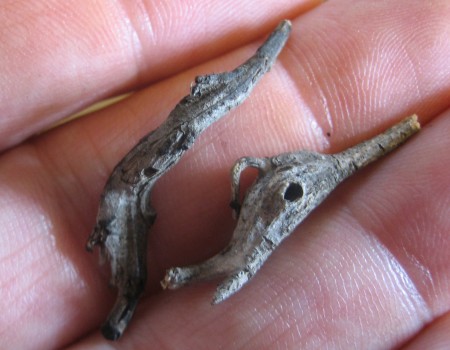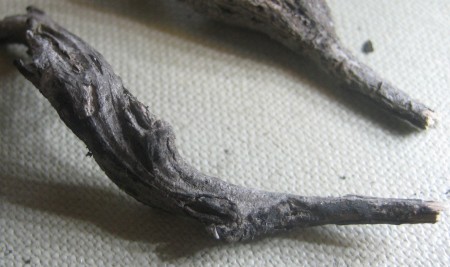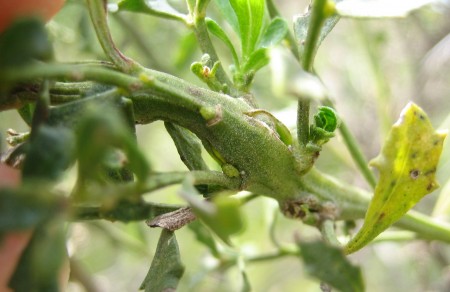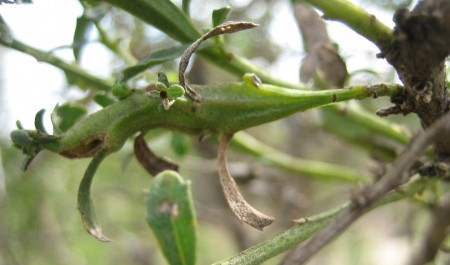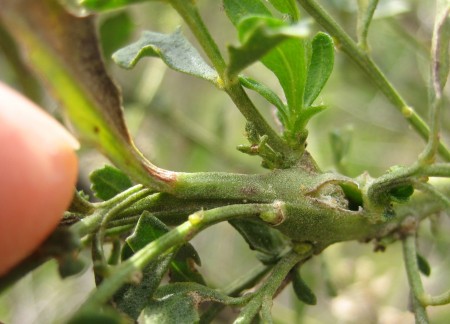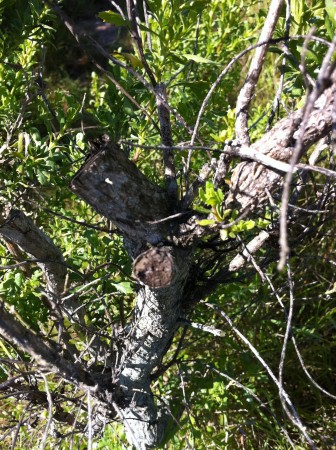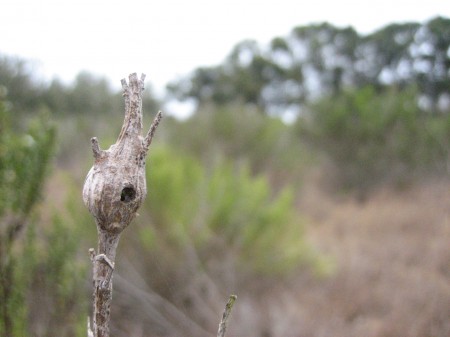I continue to be fascinated by the life history of the coyote brush bud gall midge, Rhopalomyia californica. Lately I’ve been wondering about the midge’s pupation and emergence events. Russo writes in Field Guide to Plant Galls of California and Other Western States:
When fully grown, larvae burrow to the surface of the galls, where they develop their partially protruding white cocoons and pupate. This species represents one of the rare situations among gall insects where fresh galls and emergence of adults occur throughout the year, depending on location and environmental circumstances, even though there is a pulse of growth and gall activity in spring.
I’ve looked for, but so far have never found, a gall with intact pupae visible on its surface. I’ve found plenty of galls with spent exuviae, however. Here’s one I found a few weeks ago at the salt marsh:
Here’s another gall with visible exuviae. In this case, there are actually several individual galls that I assume were the result of the same egg-laying session, though they have not merged into a single gall, as they often do. I took this shot on the morning after our first good rain of the year; I think the exuviae on the left side of the large gall may have been knocked downward by raindrops:
Here’s a gall with an odd bumpy surface:
For those who don’t want to click through for the full-sized images, here’s a cropped portion of the previous shot so you can get a good look at the exuvia:
I don’t know how long pupation lasts, but I suspect it isn’t very long, or else I should have been able to find some galls with intact pupae protruding from their surfaces. Or maybe I’m misinterpreting Russo’s description of what the pupation stage looks like. Maybe the pupae are near the surface, or barely protruding, and the exuviae end up protruding as much as they do only as a result of the emergence itself.
Here’s a gall with some interesting discolored bumps. I wonder: Could those be pupation sites? If I had cut that gall open, would I have found individual larval chambers under each of those bumps?
Cell biologist Peter J. Bryant at UC Irvine has a neat page on Rhopalomyia californica on his Natural History of Orange County, California web site. Among the photos there are several showing newly emerged male and female midges, the females identifiable by their orange abdomens swollen with masses of eggs.
Although R. californica galls are found mostly in coyote brush, they also can occur in other plants. Dr. Bryant’s page shows a gall in a leaf of black sage and the midge that emerged from it; Bryant used DNA analysis to determine that it was R. californica. He also has photos of four different types of parasitoid wasp that emerged from R. californica galls.
Dr. Bryant was kind enough to correspond with me once before (concerning the bolas spider). I think I might try pestering him again to see if he would be willing to give me any pointers on rearing R. californica galls to adulthood. I don’t necessarily want to harm the insects. Could I simply keep a removed stem in water? Or would it require a living, growing plant to avoid disrupting the lifecycle of the gall’s inhabitants?
Even if I successfully raise gall midges to adulthood, it seems likely that I would be disrupting their chance to successfully breed. The adult midge only lives for a few hours; I would essentially be sacrificing its life merely to satisfy my curiosity. Am I okay with that?
As a young boy I loved Hugh Lofting’s Dr. Doolittle stories. While writing this post I suddenly remembered a passage I hadn’t read in 40 years. It turns out to have been from Doctor Doolittle’s Garden. Doolittle, after long effort, has managed to decipher the language of insects, and has become fascinated by the Ephemera — insects with very short-lived adult stages, such as mayflies (Ephemeroptera) and gall midges (Cecidomyiidae). Doolittle and his young assistant Stubbins (of whom I was always deeply envious) bring a delicate fly into the lab.
We worked on him for half an hour and our results were very meagre. He had things to say, we felt sure. But it was a language new to us. Clearly anyone who has to pack his whole life into one day must talk very fast. We soon got the impression that he was really pouring out hundreds of words a second. Only we weren’t catching them quick enough.
“Look here, Stubbins,” said the Doctor, “we are being entirely heartless. We can’t let this poor fellow spend more than half an hour talking to us. Why, half an hour out of his life is a forty-eighth part of the whole. That would be nearly eighteen months for us. What must he think of us? Imagine anyone talking to you for a year and a half without stopping! Let him go at once. We must do this on a different system. We will catch several singly and only keep them in the apparatus for five minutes at a time, If we are swift enough with our note-taking, we shall perhaps be able to gather a little from what each one says and piece it all together afterwards and make something of it.”
The more I study R. californica the more questions I have. But in answering those questions, I don’t want to harm the object of my curiosity. I’ll have to think about this more.





